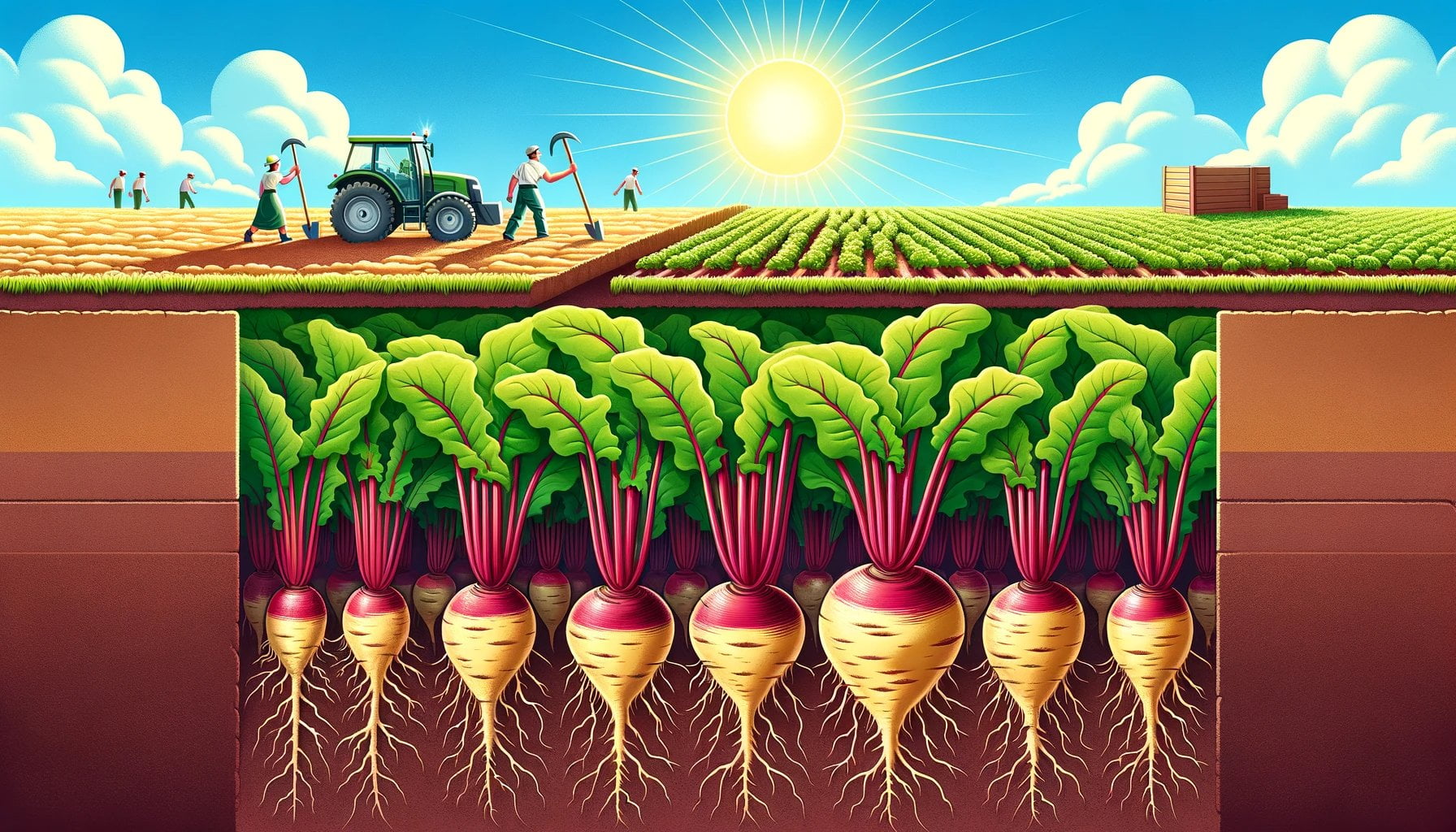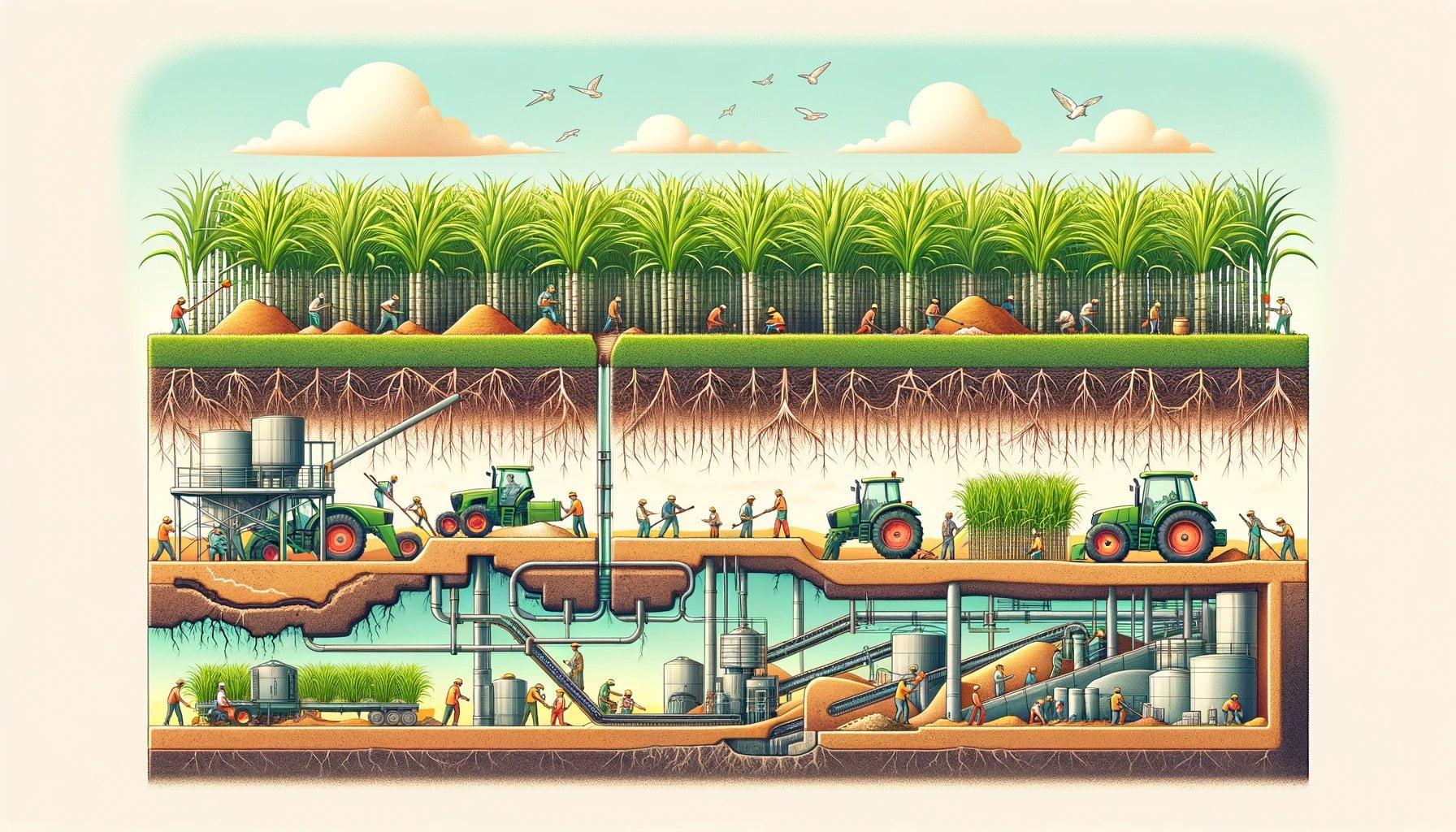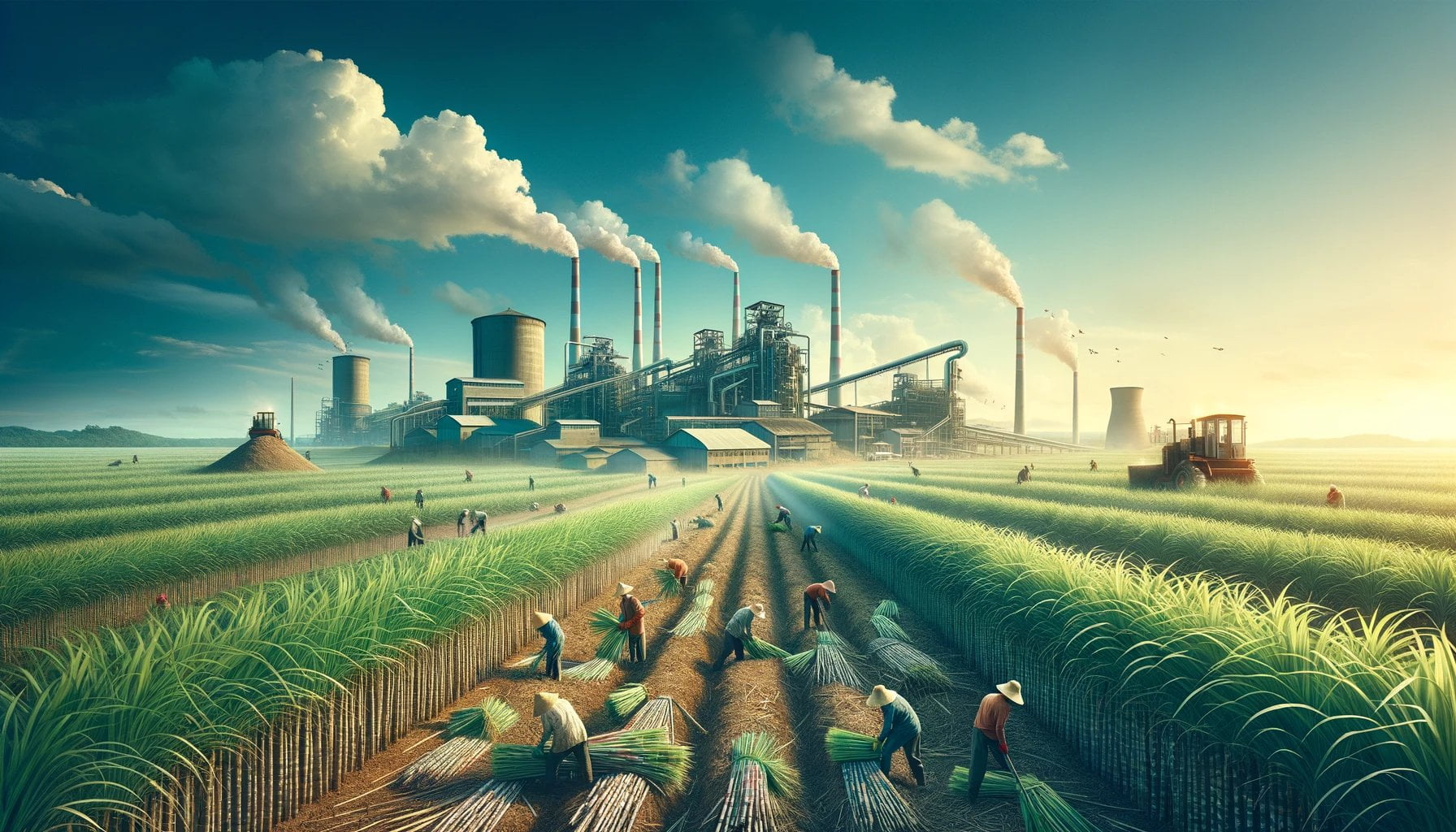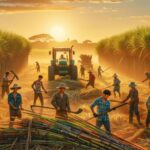Are you curious about how sugar is grown? Look no further! In this article, we will demystify the world of sugar farming and unveil the secrets behind the cultivation of this sweet ingredient. From seed selection to harvesting techniques, we will explore the intricacies of sugar farming and provide you with a comprehensive understanding of how this beloved sweetener is grown from start to finish. Join us as we uncover the fascinating journey of sugar cultivation in [Demystifying Sugar Farming: How is Sugar Grown?].

Key Takeaways:
– Sugar is produced by green plants through photosynthesis.
– Sugar can be harvested from sugar beets and sugar cane plants.
– 55% of sugar production in the United States comes from sugar beets, while 45% comes from sugar cane.
– Sugar cane is primarily grown in tropical climates like Brazil and some parts of the U.S.
– The growth process of sugar cane takes between 16-24 months.
– Sugar beets are grown in cooler climates.
– Sucrose, the main component of sugar, is concentrated in sugarcane and sugar beet, making them ideal for commercial extraction.
How is Sugar Grown?
As a key ingredient in our favorite sweet treats, sugar plays a crucial role in our daily lives. But have you ever wondered how this ubiquitous sweetener is actually grown? In this article, we will demystify the process of sugar farming, from the cultivation techniques to the harvesting methods. So, let’s dive right in!
Sugar Beets: Rooting for Cooler Climates
In cooler climates, sugar is harvested from a root vegetable known as sugar beet. These beet plants, which thrive in temperatures between 45°F and 80°F, go through a fascinating growth process. It all begins with seed selection. Farmers meticulously choose the best sugar beet seeds, taking into consideration factors such as disease resistance and optimal yield potential.
Once the seeds are selected, they are planted in well-prepared soil during the spring or early summer. As the plants grow, they develop a root system that collects nutrients from the soil to support their growth. The leaves that emerge from the beet plants photosynthesize, converting sunlight into energy that is stored as sugar in the beet’s root.
At maturity, which typically occurs after 90 to 120 days, the sugar beets are ready for harvest. Farmers use specialized machinery to extract the beets from the ground, ensuring minimal damage to the roots. These beets are then transported to sugar processing facilities where they undergo various extraction and purification processes to produce the sugar we are familiar with.
Sugar Cane: Reaching New Heights in Tropical Regions
In tropical regions, such as Brazil, Florida, Louisiana, and Texas in the United States, sugar cane takes center stage as the primary source of sugar production. Unlike sugar beets, sugar cane belongs to the grass family and can grow up to an impressive height of 20 feet.
Sugar cane requires a longer growing season compared to sugar beets, taking approximately 16 to 24 months to mature. The process begins with planting stalks, known as setts, in well-prepared soil. These setts contain buds that give rise to new cane plants.
As the plants grow, the leaves carry out the miracle of photosynthesis, converting sunlight, carbon dioxide, and water into oxygen and glucose. The excess energy is stored as sugar in the cane’s fibrous stalks. It’s like nature’s way of packing sweetness into these magnificent plants.
When the sugar cane crops reach maturity, usually between June and December, it’s time for harvest. This is where sophisticated machinery, such as mechanical harvesters, comes into play. The stalks are cut just above the ground and transported to sugar mills for further processing.
The Sweet Science of Sugar Processing
Once the sugar beets and sugar cane reach the processing facilities, they undergo a series of steps to extract the sweet nectar we all love. The detailed processes involved in sugar extraction are beyond the scope of this article, but let’s touch on the basics.
First, the sugar-rich juice is extracted from the beets or cane through crushing or diffusion. Next, impurities like fibers and juice are separated through processes like clarification and filtration. The resulting juice is then concentrated by boiling off excess water, leading to the formation of crystals.
To attain the refined sugar we are familiar with, these crystals are further washed, dried, and sometimes even treated with chemicals for purification. The final product is white, granulated sugar, ready for packaging and distribution to fulfill our sweet desires.
In Summary
So, there you have it! Sugar farming is a fascinating process that starts with the careful selection of sugar beet seeds or the planting of sugar cane setts. Through the miracle of photosynthesis, these plants convert sunlight into energy, storing it as sugar in their respective parts.
Sugar beets thrive in cooler climates and mature within 90 to 120 days, while sugar cane flourishes in tropical regions and takes between 16 to 24 months to reach maturity. Once harvested, the sugar-rich plant material undergoes various extraction and purification processes to yield the refined sugar that is found on our tables.
Next time you enjoy a spoonful of sugar in your coffee or indulge in a sweet pastry, take a moment to appreciate the incredible journey it took for that sugar to reach your cup or plate. From the soil to the processing facilities, sugar farming is a remarkable blend of science, nature, and human ingenuity.
Did you know that sugar is harvested from sugar cane and sugar beets? Learn more about how sugar is harvested here.
Have you ever wondered how cotton is harvested? Find out about the fascinating process here.
Looking for a fun fact about sugar? Check out this interesting tidbit here.
Curious about corn syrup? Discover a fascinating fun fact about it here.
Cultivation Techniques for Maximum Yield
Sugar farming is a fascinating combination of science, nature, and human ingenuity. In order to achieve maximum yield, farmers employ various cultivation techniques that enhance the growth and productivity of sugar crops. In this article, we will delve into the intricacies of sugar beet and sugarcane cultivation, exploring the methods used to optimize sugar yield.
Sugar Beet Cultivation Techniques
Sugar beets (Beta vulgaris) are primarily cultivated in temperate regions, with Europe being the largest producer, accounting for about 75% of total beet sugar production [^1^]. To ensure successful sugar beet crop production, farmers must pay close attention to plant nutrition and irrigation management [^4^]. Additionally, effective seedbed preparation and cultivar selection play crucial roles in maximizing sugar beet yield and productivity [^5^].
When it comes to planting sugar beets, good quality planting material, or seed, is essential for improving crop productivity [^7^]. Farmers can now benefit from an efficient protocol called ‘Meristem Culture,’ which produces disease-free sugarcane seeds, thereby enhancing the yield potential [^8^]. By using disease-free seeds, farmers can safeguard their crops against various infections, resulting in healthier and higher-yielding sugar beets.
Sugarcane Cultivation Techniques
Sugarcane, on the other hand, thrives in tropical regions and requires specific cultivation techniques to achieve optimal yield and productivity. Factors such as crop varieties, growth environments, and management practices significantly impact sugarcane productivity [^10^]. Therefore, to maximize yield, farmers should choose the most suitable crop varieties and create favorable growth environments.
In recent years, the implementation of green technologies and efficient planting methods has emerged as a valuable approach to improve sugarcane yield and productivity [^11^]. By adopting these innovative techniques, farmers can enhance their crop’s photosynthetic efficiency, ultimately boosting sugar yield.
Key Takeaways:
- Sugar beet cultivation techniques involve paying attention to plant nutrition, irrigation management, seedbed preparation, and cultivar selection.
- Good quality planting material, or seed, is crucial for improving sugar beet crop productivity.
- Disease-free sugarcane seeds, produced through protocols like ‘Meristem Culture,’ can enhance yield potential.
- Sugarcane cultivation techniques include selecting suitable crop varieties, creating favorable growth environments, and adopting green technologies and efficient planting methods.
- Green technologies and efficient planting methods can improve sugarcane yield and productivity.
Sources:
Harvesting and Processing Sugar Cane
Sugar cane, the source of one of the world’s most consumed sweeteners, undergoes a multi-stage process to extract the sugar from the cane. From harvesting to packaging, each step contributes to the production of the refined sugar we are familiar with. Let’s delve into the fascinating process of harvesting and processing sugar cane.
1. Harvesting the Sugar Cane
To obtain sugar cane at its peak sweetness, it is crucial to harvest it at the optimal time. Generally, sugar cane is harvested during late fall, when the shoots are tall and strong. At this stage, the sugar content is highest. The shoots are carefully cut close to the ground using specialized harvesters or machetes. This ensures that the maximum amount of sugar can be extracted from the cane.
2. Processing the Sugar Cane
Once the sugar cane has been harvested, it is immediately processed to prevent any decline in sugar content. The first step is to remove the leaves and cut the cane into small pieces. These small pieces are then crushed to extract the juice, which is a sugar-rich liquid. The crushing process can be achieved by passing the cane through huge rollers that press the juice out of the shredded stalks. This juice serves as the key ingredient for sugar production.
3. Boiling and Filtering the Juice
To create the syrup, the extracted sugar cane juice undergoes boiling and filtering. Firstly, the juice is filtered to remove any impurities present. It is then heated, allowing water content to evaporate and thus creating a concentrated syrup. Boiling also helps remove additional impurities that might still be present. This critical stage ensures a cleaner and more refined final product.
4. Cooling and Crystallizing the Syrup
After the syrup has been filtered and boiled, it is cooled down to facilitate crystallization. As the syrup cools, the sugar molecules begin to bind together, forming crystals. This process plays a crucial role in making the final sugar granules.
5. Centrifuging and Drying the Crystals
To separate the sugar crystals from the liquid, the cooled syrup is subjected to centrifugation. This process involves spinning the syrup rapidly, causing the heavier sugar crystals to separate from the lighter liquid. Once the separation is complete, the sugar crystals are dried to remove any remaining moisture. Afterwards, the dried crystals are ready for packaging and distribution.
Key Takeaways:
- Sugar cane is harvested at its peak sugar content, typically during late fall.
- The harvested cane is processed by cutting it into small pieces and crushing it to release the sugar-rich juice.
- The juice is then boiled and filtered to remove impurities, resulting in a concentrated syrup.
- The syrup is cooled to promote crystallization, which forms sugar crystals.
- Centrifugation separates the sugar crystals from the liquid, and the crystals are subsequently dried for packaging and distribution.
Sources:
– shuncy.com
– cravingsinamsterdam.com
Environmental and Social Impacts of Sugar Production
The cultivation and production of sugar have far-reaching consequences for the environment and society. From the loss of natural habitats to intensive water use and agro-chemical usage, the impacts of sugar production are significant and need to be addressed. In this article, we will explore the environmental and social implications of sugar farming and highlight the importance of sustainable practices in the industry.
Environmental Impacts
Sugar production has been linked to various environmental issues that can negatively affect ecosystems and biodiversity. One of the primary concerns is the loss of natural habitats due to the clearing of land for sugarcane cultivation. This has led to a significant reduction in biodiversity in sugar-producing areas. Additionally, soil erosion and runoff from sugar farms contribute to water pollution and nutrient leaching, resulting in degraded water quality in downstream ecosystems.
Another environmental impact of sugar production is the intensive use of water resources. Sugarcane requires a substantial amount of water for growth, leading to excessive water consumption in water-stressed regions. This can strain local water supplies and exacerbate water scarcity issues. Furthermore, the heavy use of agrochemicals, such as pesticides and fertilizers, in sugar farming can contribute to water and air pollution, harming both aquatic and terrestrial ecosystems.
Social Impacts
The social impacts of sugar production are equally significant. Local communities near sugar farms may experience adverse effects on their health and well-being. Exposure to agrochemicals used in sugar farming can pose health risks to farmers and nearby residents. Moreover, the displacement of indigenous and marginalized communities due to the expansion of sugarcane plantations has been reported in some regions.
Furthermore, the economic dynamics of the sugar industry can impact social structures within communities. Price fluctuations and competitiveness can lead to the expansion and contraction of sugar production, affecting livelihoods and local economies. It is crucial to ensure that the sugar industry operates in a socially responsible manner, taking into consideration the well-being of workers and local communities.
Sustainable Practices for Mitigation
To address the environmental and social impacts of sugar production, sustainable practices must be adopted throughout the industry. By implementing sustainable agricultural techniques, such as precision farming, organic farming, and integrated pest management, the use of agrochemicals can be minimized, reducing their negative effects.
Efficient irrigation methods, such as drip irrigation, can help mitigate the water-intensive nature of sugarcane cultivation. Water management strategies, including water recycling and conservation, can promote responsible water usage and minimize the strain on local water resources.
Additionally, the adoption of responsible land-use practices, such as land preservation and reforestation efforts, can help restore and protect natural habitats affected by sugarcane cultivation. Sustainable land management practices, including erosion control measures and the use of cover crops, can help prevent soil erosion and improve soil health.
By promoting sustainable practices in the sugar industry, environmental impacts can be reduced without compromising productivity or profits. Responsible sourcing and certification programs can also play a significant role in driving positive change, ensuring that sugar production aligns with environmental and social standards.
Key Takeaways:
- Sugar production has significant environmental impacts, including habitat loss, water pollution, air pollution, and soil degradation.
- It also has social impacts, such as health risks for farmers and nearby communities, and the displacement of indigenous and marginalized communities.
- Sustainable practices, including precision farming, efficient irrigation, and responsible land management, can help mitigate these impacts.
- Certification programs and responsible sourcing can drive positive change in the sugar industry.
Citation:
1. WWF. “Sugar and the Environment – Encouraging Better Management…” Source
2. WWF. “Environmental Impacts of Sugar Production.” Source

FAQ
Q1: What are the primary sources of sugar for commercial production?
A1: The primary sources of sugar for commercial production are sugar beets and sugar cane. Sugar beets are grown in temperate regions, while sugar cane is grown in tropical climates.
Q2: How long does it take for sugar cane to mature?
A2: The growth process of sugar cane typically takes between 16 to 24 months before it reaches maturity and is ready for harvest.
Q3: What are the important factors for successful sugar beet crop production?
A3: Plant nutrition and irrigation management are important factors for successful sugar beet crop production. Seedbed preparation and cultivar selection also play key roles in sugar beet yield and productivity.
Q4: What methods can be used to improve sugarcane crop productivity?
A4: Efficient planting methods and utilizing green technologies can help improve sugarcane yield and productivity. Additionally, balancing between productivity and increasing the planting land area is required to meet the demand for sugar.
Q5: What are the environmental impacts of sugar production?
A5: The cultivation and processing of sugar have significant environmental impacts, including the loss of natural habitats, intensive water use, heavy agro-chemical usage, and pollution of air and water. These activities contribute to the degradation of wildlife, soil, air, and water in sugar-producing areas and downstream ecosystems.
















